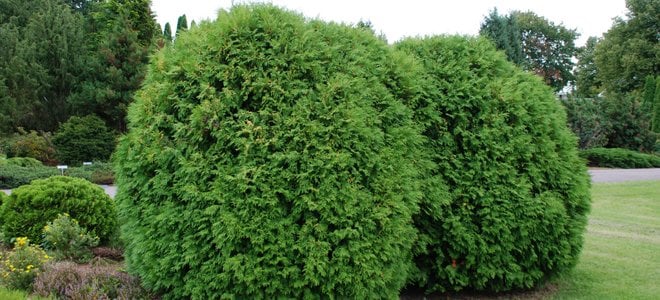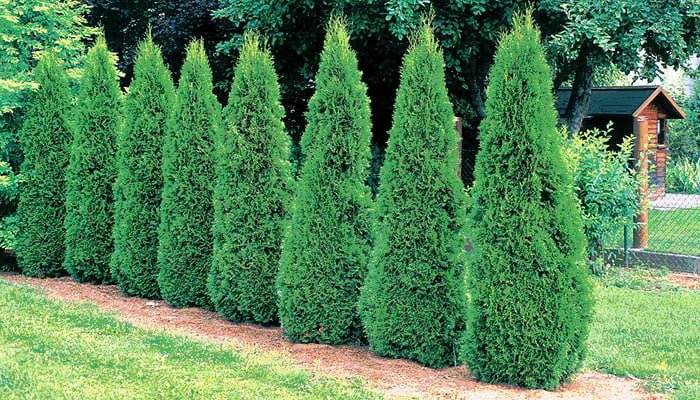An Arborvitae tree is an evergreen from the cypress family. They come in a variety of shapes and sizes, and they are easy to maintain and grow. Arborvitaes are often used for privacy and windbreak. Tree service and care of Arborvitae trees may vary based on the type.
Types of Arborvitae:
- American Arborvitae – This is the most common of the Arborvitae varieties. It can reach a height of 25-40 feet and a width of about 10-15 feet. If you are looking for a smaller version of this, there are also dwarf versions that are popular in landscape designs. The American Arborvitae is bright green in color at the top, with paler colors towards the bottom. They grow best in moist environments.
- Emerald Green Arborvitae – Also known as white cedar, the Emerald Green variety is named after the fact that it turns a darker shade of green as it matures and grows. The Emerald Green can grow as tall at 30 feet and as wide at 10 feet. It grows into a distinctive pyramidal shape naturally. Because of this, little to no pruning is required. They thrive in swampy areas.
 Globe Arborvitae – Like the Emerald Green, the Globe Arborvitae also achieves its shape without pruning. Like the name implies, its natural shape is round. The Globe variety only grows to be about 5 feet tall, but is still great for wind block for smaller plants, and can serve as a landscape accent. They need full sun to avoid turning a shade of brown.
Globe Arborvitae – Like the Emerald Green, the Globe Arborvitae also achieves its shape without pruning. Like the name implies, its natural shape is round. The Globe variety only grows to be about 5 feet tall, but is still great for wind block for smaller plants, and can serve as a landscape accent. They need full sun to avoid turning a shade of brown.- Techny Arborvitae – This variety is great for your property if you want to grow a shield in just a few years. Technys are slender and tall, reaching about 20 feet tall and about 6 feet wide and they are great in surviving atmospheres with harsh winters.
When to plant:
- Arborvitaes can be planted at any time of year except during a summer drought.
- They are great at adapting, but do prefer cooler, moist climates.
Recommended tree care and tree service:
- Tree pruning (Although most arborvitaes do not require pruning to maintain their shape, hiring a tree arborist to rid trees of dead or broken limbs is important in preventing decay.)
- Watering
- Fertilizing
Arborvitae diseases and pests:
- Bagworm – This is a type of moth whose caterpillars feed on arborvitae leaves and branches. Some warning signs are defoliation and bags hanging from the tree. A bagworm infestation can seriously stunt the growth of your tree and cause severe defoliation.
- Spider mites – They can cause leaves to gray and/or brown
- Aphids – These pests suck the sap from arborvitaes. This will stunt the growth of the tree and cause yellowing, browning, or wilting.
- Tip Blight – This is caused by fungus. Trees with injuries from insects, sun scorch, or freezes are more susceptible to this fungus.
All of these pests can lead to disease and potentially death of your Arborvitae trees. Because of this, pest prevention methods are extremely important. Any “tree service near me” search can help you to find a reputable tree service company to implement pest prevention plans. An arborist and/or tree service professional can also help you to manage pests and/or disease if your trees have already been infected. Early detection is key in recovery. By hiring a professional tree service, like Red Cedar, you are ensuring that the proper diagnosis will be made, and thus the proper care plan executed.
The trained professionals at Red Cedar can also plant and maintain your arborvitaes for you! Our landscape design team can help you choose the best variety for your needs, and determine the best spot, and time of year for planting. Once planted, our arborists can take over and make sure your Arborvitaes are thriving and growing to their full potential! Ready to get started? Contact Red Cedar today for your free consultation!



I like how you said that a good the service should be able to prune your trees when necessary. I also like how you said that they should be able to water and fertilize. My husband and I need our trees taken care of well, and we just don’t have the time! That’s why we are looking to hire a good tree service.